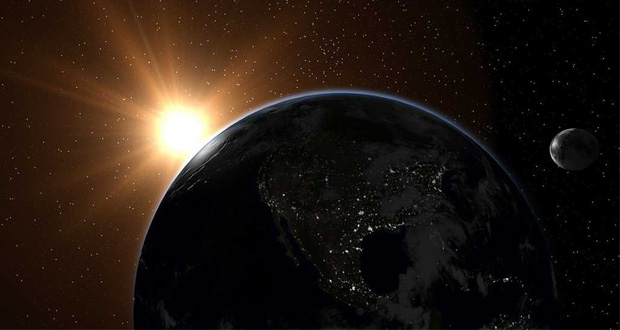Visit Islam21c.com/PTC for your city’s Ramadān calendar. You can also receive daily prayer times for your exact location using our handy telegram bot.
Click to read: Fasting & Prayer Times Will Be Different This Ramadan
The occurrence of Ramaḍān along with the beginning times of ʿIshā’, Maghrib and Fajr prayers during summer leads to confusion for some Muslims living in Europe and North America, and of course, given that the accuracy of prayer times is ever more sensitive during Ramaḍān, it is important for the Muslim community to confirm the correct time for commencing fasts. This article will discuss the starting times of the fast, known to some people as sehri, suḥur, or imsak. It will also recommend a time for the ʿIshā’ prayer as well as the Tarawīḥ (night prayer) during the holy month.
When is the Fajr prayer?
The beginning time for the Fajr prayer is the start of the time for fasting according to all Muslim scholars. The basis of this consensus is the verse,
“And eat and drink until the white thread (light) of dawn appears to you distinct from the black thread (darkness of night), then complete your Saum (fast) till the nightfall.”[1]
The Prophet (sall Allāhu ʿalayhi wa sallam) instructed the Companions,
“The athān (call to prayer) of Bilāl should not prevent you from eating Sahūr (predawn meal) because he gives athān at night, therefore keep eating and drinking until you hear the athān of ʿAbdullāh b. Umm Makktum. He (ʿAbdullāh b. Umm Makktūm) gives athān when the fajr comes out.”[2]
The Fajr referred to in the ḥadīth is the true Fajr: al-Subh al-Sadiq. Samrah ibn Jundub related that the Prophet (sall Allāhu ʿalayhi wa sallam) stated, “The vertical light (al-Fajr al-Mustateel which is the false Fajr) should not prevent you from eating (Sahoor). You can eat and drink until the light appears to spread (al-Fajr al-Mustateer – the true Fajr).[3]
How do we decide on how to ascertain the correct time for Fajr?
Although most scholars agree on both the Shar’ῑ signs given in the divine text concerning the start of Fajr, they disagree on how to interpret the Shar’ῑ signs as actual astronomical phenomena. And even when an interpretation is decided on, scholars differ on how to deal with fasting and the five daily prayers due to the abnormality in the timing of prayer during summer in Europe and North America.
Shar’ῑ signs and Mushāhadah
After confirming the Shar’ῑ sign for the start of fasting and the Fajr prayer, how do we decide on al-Subh al-Sadiq in actuality? Is it when we, either as individuals or as single communities, actually see it (Mushāhadah) or merely when we confirm that the actual astronomical phenomenon takes place even though it has not been seen? If it is when the astronomical phenomenon actually takes place, how do we decide that it definitely has done so?
Much has been written on the topic and thus a repetitive discussion need not take place here. However, I will provide key points that should allow us to decide on the matter. The only way to decide the start of al-Subh al-Sadiq is the Mushāhadah of the phenomenon, that is, a global and widespread witnessing of this phenomenon in which we can confirm the presence of the light on the horizon, i.e. al-Subh al-Sadiq. This Mushāhadah produced a formula that was used as a criterion to establish that the prayer time had started even if a specific Mushāhadah for that place or time did not take place due to numerous factors such as weather conditions, weakness of eyesight, or ignorance of the actual interpretation of the Shar’ῑ sign itself. For example, if a person intends to break his fast but is unable to see the sunset due to some reason, then he may still break his fast when the supposition that the sun has set in accordance with its regular occurrence. Similarly, a person cannot continue eating his predawn meal claiming that he could not see al-Subh al-Sadiq himself. One may know the time of al-Subh al-Sadiq either by comparing it to the previous day, the testimony of a second person, or by calculation. In fact, he can record the prayer timetable for a complete year and then use it in the following years – he does not need to witness the Shar’ῑ signs every time a prayer time comes in. Allāh said about prayer times,
“Perform As-Salat (Iqamat-as-Salat) from midday till the darkness of the night (i.e. Zhuhr, ʿAsr, Maghrib, and ʿIshā’ prayers), and recite the Qur’ān in the early dawn (i.e. the Morning Prayer). Verily, the recitation of the Qur’ān in the early dawn is witnessed.”[4]
The verse establishes that prayer times are linked to actual astronomical phenomena rather than seeing it with the naked eye – this in contrast to the ḥadῑth concerning the start of Ramaḍān which is linked to the notion of physically sighting the moon and not depending on astronomical actualities. The Prophet (sall Allāhu ʿalayhi wa sallam), “Fast when you see the moon and cease your fast when you see the moon.”[5] It is the consensus of classical Muslim scholars that astronomical calculations cannot be used as a replacement for actually sighting the moon (for Ramaḍān) with the naked eye. This is the difference between sighting the moon, which is needed to confirm the start of the month of Ramaḍān or Hajj, and the sighting of the twilight which is used to decide prayer times.
18 degrees below the horizon for Fajr, and either 17 or 18 degrees for ʿIshā’
It is with this in mind that we may conclude that an individual’s Mushāhadah for prayer times must not negate the accepted criterion that was originated by global and widespread mushāhadah (of when twilight occurs and disappears) established in different countries and throughout the centuries. That criterion is the basis for the decision of both Muslim jurists and astronomers that Fajr should be calculated when the sun is at 18 degrees below the horizon for Fajr, and either 17 or 18 degrees for ʿIshā’. It should be noted that the slight choice offered for ʿIshā’ times is insignificant and thus there is no need to discuss it here.
Many scholars at different times throughout the course of history, and in many different regions of the world, have sighted (with the naked eye) the Shar’ῑ signs given in the divine text and calculated that it corresponds with 18 degrees below the horizon criterion, a fact that they have then recorded. Given that so many scholars from different places of the world and at different periods during the last thousand years have come to produce the same calculation lends overwhelmingly more weight to the 18 degree formula than a few people gathering in one part of the world during the same period to come up with a divergent opinion. This is not a matter of differences amongst schools of thought as the overwhelming majority of scholars amongst various sects and schools of thought agree with the 18 degree formula. I have recently discussed the issue with Mufti Taqi Uthmani (in the company of other scholars) who stated that he himself along with 99% of the scholars of the Indian sub-continent viewed the 18 degree formula to be the correct calculation for prayer times.
What is the correct Mushāhadah for Fajr?
Muslim astronomers as early as Mohammed ibn Jabir ibn Sinan, famously known as Albategnius (d. 929 CE), confirmed that Fajr and ʿIshā’ Shar’ῑ signs are visible when the sun is 18 degrees below the horizon. Other scholars stated that there is a consensus in regards to this conclusion. Among the very last conferences at which this issue was discussed thoroughly was the one organized by the Fiqh Council of the Muslim World League in 1986 where scholars and astronomers from various backgrounds and schools of thought confirmed that Fajr appears when the sun is at 18 degrees below the horizon in the east. They also confirmed that ʿIshā’ time appears when the sun is at 17 degrees below the horizon from the west. This decision was reiterated by the same fiqh council in 2007 in response to a query sent to the council by the central Mosque in Belgium.
The following table shows the various institutes that are referred to for the Fajr and ʿIshā’ times currently in use in many countries:

* ISNA traditionally held the latest Fajr time due to an adopted angle of 15 degrees. But in September 2011 they revised their position to 17.5 degrees which is more or less in line with the rest of the World.[6]
** It has been widely attributed to them to hold the position of 19 degrees which is even earlier Fajr or a position of 90 mins after Maghrib for ʿIshā’. Although in using calculation of 18 degrees the times for Fajr are virtually the same in Makkah which indicates that the 90 minute position is in effect the same as 18 degrees and due to its equatorial position this does not change much at all throughout the year.
As you may see from the timetable, most of these institutes consider 18 degrees as the minimum degree for calculating Fajr time.
Hizbul Ulama (UK) and a mistaken understanding of Mushāhadah
The Hizbul Ulama timetable is one that has been adopted by a number of mosques around the UK including the recent ‘Unified prayer timetable for London’ adopted by East London Mosque and Regents Park Mosque. The fact that these organisations have sought to unite the Muslim community is an extremely praiseworthy matter, indeed unity is one of the most important factors that leads to the strengthening of the Muslim community and I commend them for their sincerity. However, I sincerely believe that the Hizbul Ulama have overlooked many important fundamentals such as being unable to identify the main criterion for deciding prayer times – they mistakenly assume that it is through individual Mushāhadah. As a result of this, they have never compared their Mushāhadah with the Mushāhadah of others both within the UK and outside of it. They have opposed the overwhelming number of jurists and contradictorily claim that last year’s Mushāhadah may be used for this year whilst maintaining that an individual may only pray when he himself has seen the Shar’ῑ sign!
According to the Hizbul Ulama timetable, the length of the Maghrib twilight in winter is either equal or longer than that of summer when it is well known that summer has longer days. Similarly, their timetable posits that the length of the twilight in London is almost the same as that of Makkah although London is of high latitude (L 51° 30) whereas Makkah al-Mukarramah is of much lower latitude (L 21° 25). It is examples such as these (of which there are more) that simply demonstrate the unreliability of the Hizbul Ulama methodology in ascertaining the correct prayer times.
Advice for the laity and mosque committees
No one can claim that one should merely follow the textual evidences since the issue is related to interpretation. It is true that some individuals might not be convinced with a particular conclusion, yet it would be destructive to the deen of Allāh to leave it to individual choice. The Muslim is obliged to abandon many of his own conclusions for those agreed upon by the consensus of the scholars which is invariably based upon the Qur’ān and Sunnah. Indeed, an individual might adopt a particular conclusion himself, but he should not instruct others to abandon the mainstream Islamic opinion for his own personal conclusion. I appeal to committees of mosques not to conclude on any matter which is divergent from those adopted by the overwhelming majority of Muslims. The basis for this is the authority given by the sharῑʽah to the consensus of Muslim scholars. The Prophet (sall Allāhu ʿalayhi wa sallam) stated that his Ummah would never agree on an error and thus the minority opinion cannot stand against the vast majority where the overwhelming majority is in fact equivalent to consensus.
Why shouldn’t individuals follow their own mosques?
Individual acts of worship are matters that a person will be questioned about, and those acts of worship that are not linked to other Muslims are not included in acts of worship that a person can give up for the sake of unity or to merely blindly follow others. Although people should pray in congregation at their local mosques, the start of fasting is not connected to the timing of the local mosque. Therefore, the person should exert effort to identify the correct position that will free him from any burden on the Day of Judgment.
What about the issue of tabayyun?
The overwhelming majority of classical scholars adopted the 18 degree calculation for Fajr and 17 or 18 degrees for ʿIshā’, and for this reason there is no real disagreement that might be used as a justification for Ijtihād or adopting the easiest option. Moreover, Tabayyun should take place when we are not quite sure whether the light of Fajr is apparent. However, those who adopt the 18 degree formula are certain of the appearance of the Fajr light and thus Tabayyun is achieved without adopting a lower degree.
What about ʿIshā’? What can we do during the summer period when the twilight persists?
According to the 18 degrees calculation, there is a period during summer (for countries above a certain latitude) where the Maghrib twilight does not actually disappear – a phenomenon known as the persisting twilight (where the Shar’i indications for the occurrence of ʿIshā’ do not become visible). The time for ʿIshā’ is too late whilst the time for Fajr is too early immediately before and after this period. For example, this period starts in London on 26th May whereby the persisting twilights remain until approximately 12:35 and Fajr starts at around 1: 15 a.m. The period ends around the 19th July where Fajr is 1:18 a.m. During the period of absence of Shar’ῑ signs scholars have suggested two main methods:
1) Estimation, or
2) Adopting the time of the last day when the Shar’ῑ signs were visible.
Estimation creates a big gap between the last day the sign is visible and the day after. Similarly, it creates a big gap between the day the signs are not visible and the day after. The only consistent method is adopting the time of the last day in which the sign was visible all the way up until it becomes visible again. This is a systematic method in which no large gaps are witnessed between different days.
Having written this and respectfully disagreeing with others, I urge all to maintain the Islamic etiquette of differing. We should not allow such differences to disunite us or place enmity in our hearts. May Allāh keep us united, keep our hearts pure, and forgive our shortcomings.
For a prayer timetable for any location in the world visit Islam21c’s Prayer Times Calculator.
Video: The correct time for Fajr and fasting in Europe
[donationbanner]
Notes:
Source: www.islam21c.com
Islam21c requests all the readers of this article, and others, to share it on your facebook, twitter, and other platforms to further spread our efforts.
[1] Al-Qur’ān 2:187
[2] Al-Bukhārī and Muslim
[3] Sunan al-Tirmidhi
[4] Al-Qur’ān 17:78
[5] Narrated by Abu Hurairah and Abdullah b. ʿUmar; al-Bukhārī and Muslim.
[6] http://www.icoproject.org/ISNA-Adopts-New-Angles-for-Fajer-and-Isha_ad-id!81.ks
[7] al-Tuhfah Al-Shahiyah [8] Hashiyah Sharh Jagmayni
[8] Hashiyah Sharh Jagmayni










